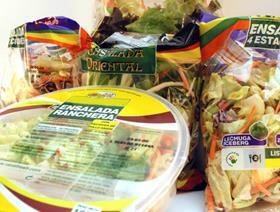
Bagged salads and fresh-cut produce has been in rising demand over the last few years, but bagged produce still faces problems from bacteria.
A new technology to overcome that problem has been developed by Dr Kevin Keener, of Purdue University in the US, according to the Guardian News Service.
Traditionally, produce is chlorine washed or ozone treated before bagging to remove bacterial contamination. Dr Keener’s technology moves that to the bag itself, by generating ozone within it.
The technology is a development from Dr Keener’s work on atmospheric, non-equilibrium plasmas (ANEP), the traditional ozone production method for produce treatment. ANEP requires a special treatment chamber.
“I started thinking about what we could do to recreate ANEP without the costly chamber process,” Dr Keener said. “My question became: ‘Can we place the generation method outside the container and, if so, what would be our limitations?’”
His solution was to generate the ozone within the bag using electrode plates above and beneath it, creating a room-temperature plasma field inside, partially ionising the air and creating ozone from split oxygen molecules.
The treatment does not raise the temperature of the produce to any practical degree, and kills in the range of 99.999 per cent of bacteria, reported the Guardian.
The ozone exists in the bag for some hours, rather than the exposure measured in minutes in traditional treatments.
“In our system, because we are doing it in-package, we can deliver a specific ozone concentration which natural decay processes will convert back to normal `oxygen` after a known time,” said Dr Keener.
The system can also be adapted to conveyer-belt speeds.
The treatment is still in development, and has encountered some problems, such as discolouration in spinach.
Determining the technology’s effect on produce needs more research at the moment, but Dr Keener’s system has already drawn enquiries from equipment manufacturers and multinational companies.






No comments yet